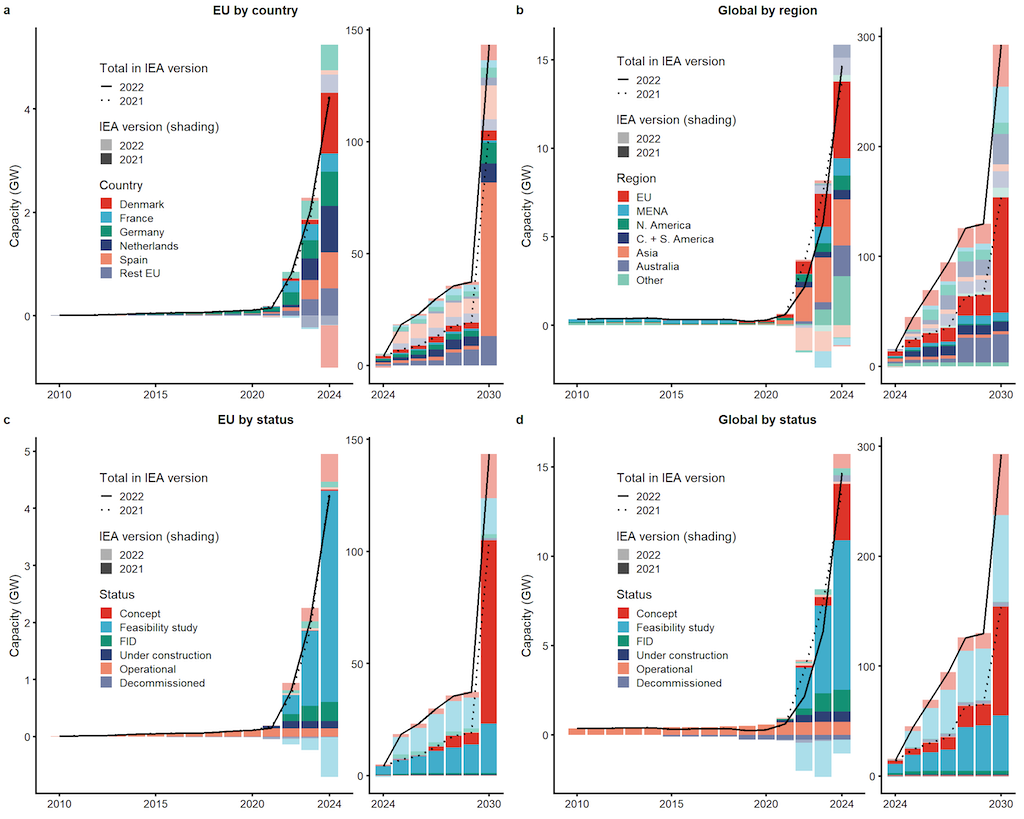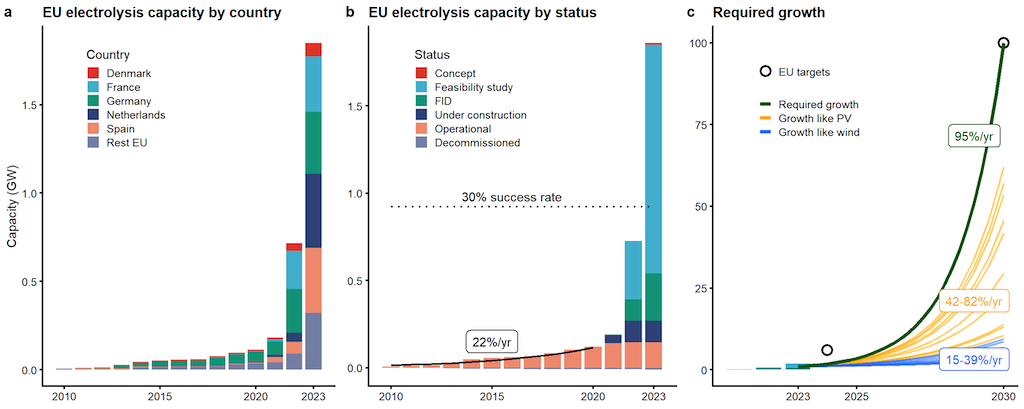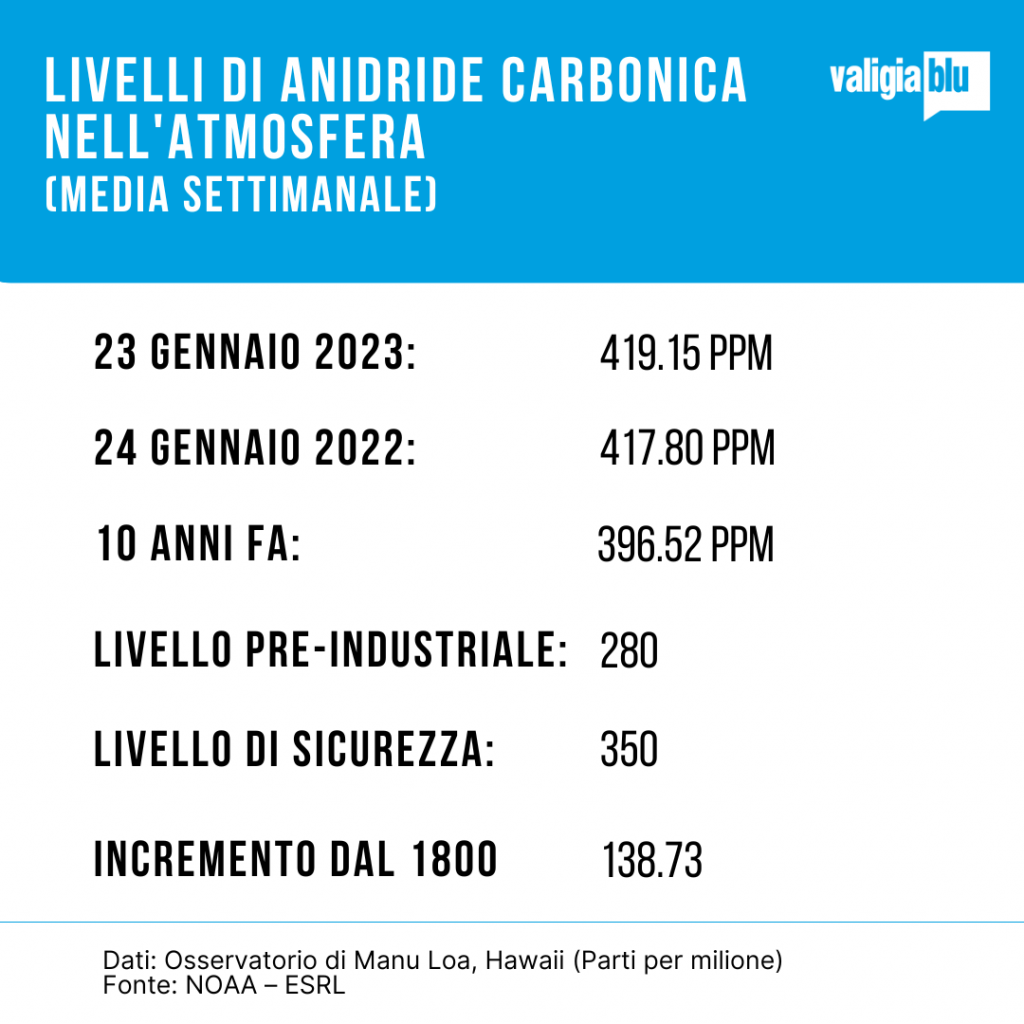https://www.valigiablu.it/crisi-climatica-idrogeno-verde-produzione-futuro/
- |
The weekly round-up on the climate crisis and data on carbon dioxide levels in the atmosphere.
“Hydrogen's big gamble:fluff or is it the Holy Grail of net zero emissions?”, was the headline of one article of Guardian last October who wondered whether we can really rely on green hydrogen to achieve climate goals.
An article by Adrian Odenweller and Falko Ueckerdt of the Potsdam Institute for Climate Impact Research, authors of one study published on Nature Energy in September, he tried to answer this question by analyzing how quickly the world would need to produce green hydrogen – produced by splitting water with electricity generated from low-carbon sources – to help limit warming to 1.5°C.
Hydrogen:a solution to climate change or another gift to the fossil fuel industry?
Hydrogen is set to become one of the building blocks for achieving global climate goals, but current production comes almost exclusively from high-carbon sources.
It is largely produced by splitting hydrocarbon molecules, emitting tens of millions of tons of CO₂ and, during the supply chain, also methane.Therefore it is called in jargon 'grey hydrogen'. Then there is the 'blue hydrogen', with lower carbon content:the CO₂ emitted during the production process is captured and stored using Carbon Capture and Storage (CCS) techniques.Hydrogen 'black' it is produced using coal;that 'brown' with lignite;that 'turquoise' where heat is used to split fossil gas by pyrolysis (the decomposition of a complex substance by heat treatment);that said 'viola' (or also 'pink' or 'yellow)' where electricity and heat from nuclear reactors are used;that for now without color produced using biomass.
Hydrogen classified as clean or 'green', with very low or practically zero carbon content, is instead produced by electrolysis of water.Through the supply of electricity, the water molecule is split into hydrogen and oxygen.When the electricity used in this process comes from a renewable source (mostly wind and solar energy), it is practically carbon free, i.e. it has an almost zero carbon content.
According to the study by Odenweller and Ueckerdt, to truly rely on green hydrogen to limit the 1.5°C increase in temperatures from the pre-industrial age by 2050, we would need to increase the capacity of electrolysers by 6,000 times compared to current levels of 600 megawatts (MW).Which would require growth rates similar to those achieved by the United States for military equipment in World War II.A pace of growth that is unthinkable without rapid political interventions.
“Our analyzes – explain the two scholars – suggest that even with a growth speed similar to that of wind and solar energy, the capacity of the electrolysers would not be able to guarantee more than 1% of the final energy by 2030 in the EU and 2035 globally – well below needs under 1.5°C scenarios.”
At the moment, the accelerating deployment of alternatives to hydrogen, such as electric cars, electric trucks and heat pumps, offers a hedge against the risk that hydrogen deployment will fail to meet the expectations placed on this vector energetic.
Projects in the pipeline
In 2021, globally, the capacity of hydrogen electrolyzers was approximately 600 MW.In the NZE scenario (Net-Zero emissions by 2050), the International Energy Agency (IEA) he foreshadowed an increase in this capacity of 3,670 gigawatts (GW), i.e. 6,000 times more.
If all projects announced in the European Union and around the world are implemented, global electrolyser capacity will reach 300GW by 2030.

The current electrolysis capacity – explain the two researchers – is comparable to the capacity of solar photovoltaic (PV) in 2000.To reach 300GW, it took 17 years.If all the announced projects materialize on schedule, green hydrogen would take half the time.However, investment commitments in electrolysers are lagging behind.More than 80% of the capacity announced to come online in 2024 is not yet supported by a final investment decision.All this does not bode rosy scenarios.
What the European Union is doing
About half of the projects in the pipeline are in Europe.The REPowerEU package it has set itself the objective of producing 10 million tonnes (Mt) of green hydrogen by 2030 and importing another ten.Producing every 10 Mt of hydrogen would require approximately 100 gigawatts (GW) of electrolysis capacity.
Most of the projects have been subjected (or are in the process of being subjected) to a feasibility study.If 30% of these projects were implemented by 2024, as expected, installed capacity would still need to double each subsequent year to meet the targets set by 2030 [bottom right in the figure below], with a growth rate of 100% – needed to double capacity every year – unprecedented for energy technologies and well above those historically seen for solar and wind.

What if green hydrogen had the same growth rates as wind and solar?
In the case of growth rates similar to those of wind and solar, Odenweller and Ueckerdt's analyzes show that green hydrogen could be scarce in the short term and become – but there is no certainty – more abundant in the long term.
Under this scenario, green hydrogen would probably provide less than 1% of final energy by 2030 in the EU and 2035 globally, well below the needs envisaged in the 1.5°C scenarios.
“Our simulations indicate that a 'turn' towards high electrolyser capacities is likely in the coming decades.However, the timing and extent of this change is highly uncertain.For the EU, our simulations predict a 'turning point' around 2038;globally, around 2045,” the two researchers write.A period of time far beyond the ambitions placed in green hydrogen.
Rapid coordination and interventions by governments are needed
To achieve the objectives envisaged by REPowerEU, high growth rates would be needed which would be able to fill the short-term shortage.However, achieving emergency expansion would require interventions on a wide range of technologies ranging from World War II-era US military equipment to China's high-speed rail network or highly modular technologies, such as smartphones and servers. Internet".
This rate of growth requires rapid and decisive action, global coordination and special financing, explain Odenweller and Ueckerdt.Governments should support corporate investment, and coordinate to regulate and manage the simultaneous increase in supply, demand and infrastructure for hydrogen production and use.Recently, the EU and the US have pushed forward new hydrogen policies to break the vicious cycle of uncertain supply, insufficient demand and incomplete infrastructure.It remains to be seen whether this effort will be enough.
At the moment 'blue' hydrogen - obtained from gas by capturing and storing carbon dioxide - could play a bridging role.However, concerns about emissions remain during the life cycle and sharp increases in gas prices in the EU have complicated the competitiveness of blue hydrogen.
Until uncertainties about availability and costs clear, political leaders will need to be aware of the risk of overestimating hydrogen's potential.If supply exceeded expectations, there would always be the potential to expand hydrogen use cases.Conversely, if hydrogen is relied upon to decarbonise sectors and supply is lower than expected, it may be too late to switch to alternatives in time for climate goals.
This suggests that the expansion of already available and more efficient alternatives, such as direct electrification with heat pumps, electric cars and electric trucks, offers a way out if hydrogen proves to be a non-viable route.
Colombia announces a halt to new oil and gas exploration for a greener economy
The Minister of Mines, Irene Vélez, declared at the World Economic Forum in Davos that Colombia will not approve new oil and gas exploration projects, in an attempt to abandon fossil fuels and move towards a new sustainable economy.The decision, however, will have to overcome opposition from economic, political and industrial sectors.
Full article here 👇
Colombia announces a stop to new oil and gas exploration for a greener economy
Indian industry switches to biomass after New Delhi bans coal use in fight against pollution
In an effort to combat local air pollution, New Delhi banned coal burning starting in January.The decision pushed around 800 small industries to use biomass.Switching to biomass, which usually consists of pellets or rods of agricultural residues, will lead to reduced emissions and push farmers to sell these residues instead of burning them, regulators said.
Full article here 👇
Indian industry switches to biomass after New Delhi bans coal use in fight against pollution
Balkans, the Drina river is becoming a floating landfill
Tons of plastic bottles, rusty barrels, used tires, household appliances, driftwood and other waste:the Drina river, known for its extraordinary natural beauty, has turned into a giant pile of floating waste.It is estimated that around 10,000 cubic meters of waste have accumulated in recent days.And the solution won't be solved by cleaning up the river.
Full article here 👇
Pull fuel out of the atmosphere.The new challenges to make flights more sustainable
In the years before the pandemic, aviation emitted about a billion tons of carbon dioxide per year, about as much as the entire South American continent in 2021.And emissions are rising after the end of the lockdowns.However, major airlines have committed to achieving net-zero carbon emissions by 2050.There are many new technologies in the pipeline, such as fully electric planes, or the use of hydrogen or cleaner-burning biofuel.But perhaps the most interesting potential source is the air we breathe, which is naturally full of carbon dioxide.
Full article here 👇
Pull fuel out of the atmosphere.The new challenges to make flights more sustainable
Try having a plastic-free day
Since it was invented more than a century ago, plastic has insinuated itself into every aspect of our lives.It is difficult to spend even a few minutes without being forced to touch it in our daily lives.According to a United Nations report, the world produces around 400 million tonnes of plastic waste every year.About half are thrown away after just one use.The report finds that “we have become dependent on single-use plastic products, with serious environmental, social, economic and health consequences.”The journalist A.J.Jacobs told how he lived a day without being able to use plastic to understand which plastic objects we cannot do without and which we could give up.
Full article here 👇

Preview image via iconaclima.it
